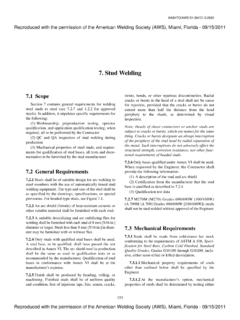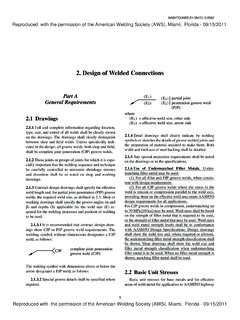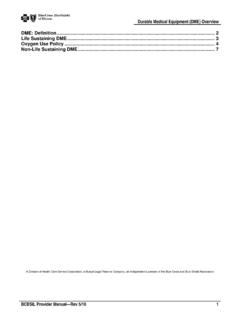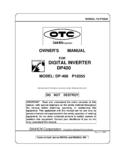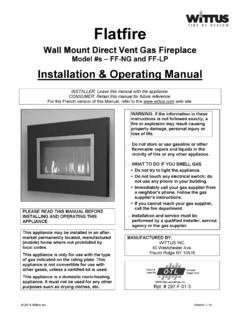Transcription of shield gas manual - AWS Section
1 SHIELDING GASESSELECTION MANUALI ntroduction 1 Properties of Electric Arcs and Cases3 Basic Electrical Concepts3 Physical Properties of Gases8 Basic Gas Properties10 Gas Tungsten Arc Welding (GTAW)13 Process Description13 Gas Flow Rate14 Preflow and Postflow15 Backup Shielding and Trailing Shields15 Shielding Gases for GTAW15 Plasma Arc Processes (PAW and PAC)19 Plasma Arc Welding (PAW)19 Process Description19 Application of PAW21 Shielding Gases for PAW22 Plasma Arc Cutting (PAC)24 Process Description24 Gas Flow Rates27 Shielding and Cutting Gases for PAC27 Gas Metal Arc Welding (GMAW)29 Process Description29 Metal Transfer Modes in GMAW30 Metal-Cored Electrodes34 Shielding Gases for GMAW35T A B L E O F C O N T E N T SChapterTopicPages1234 Flux-Cored Arc Welding (FCAW)
2 43 Process Description43 Flux Effects44 Metal Transfer44 Shielding Gases for FCAW45 The Economics of Gas Selection for GMAW47 Labor and Overhead47 Effect of Shielding Gas on Welding Speed48 Effect of Shielding Gas on Duty Cycle and Cleanup48 Consumable Costs50 Total Cost of a Shielding Gas51 Gas Supply53 Gas Supply Systems55 Cylinder Storage Systems55 High Pressure Cylinders56 Identification of Gases in Cylinders56 Carbon Dioxide Supply56 Gas Mixing57 Pre-Blended Mixtures57 Bulk Storage Systems57 Inert Gas Distribution Systems58 Precautions and Safe Practices59 Welding and Cutting59 Shielding Gases62 Material Safety Data Sheets (MSDS)63 Glossary645 ChapterTopicPage678a-zT A B L E O F C O N T E N T SDuring any arc welding process, oxygen andother atmospheric gases can react with themolten metal, causing defects that weaken theweld.
3 The primary function of a shielding gasis to protect the molten weld metal fromatmospheric contamination and the resultingimperfections. In addition to its shieldingfunction, each gas or gas blend has uniquephysical properties that can have a majoreffect on welding speed, penetration, mecha-nical properties, weld appearance and shape,fume generation, and arc stability. A changein the shielding gas composition is usuallyconsidered an essential variable in mostqualified welding primary gases used for electric weldingand cutting are argon (Ar), helium (He),hydrogen (H2), nitrogen (N2), oxygen (O2),and carbon dioxide (CO2).
4 The compositionand purity of the gas or gas mixture should betailored to meet the process, material, andapplication requirements. Shielding gases areused in either pure form or in blends of vary-ing components. Therefore, the selection of agas or gas mixture can become quite complexdue to the many combinations of the most economical shieldinggas or blend must be based on a knowledgeof the gases available, volume requirements,their applications, and the overall effect theyhave on the welding process. Praxair sShielding Gas Selection manual describes thearc plasma characteristics and basic propertiesof shielding gases, as well as their applica-tions in the welding and cutting processesmost frequently used by industry processes discussed are Gas TungstenArc Welding (GTAW), Plasma Arc Welding(PAW), Plasma Arc Cutting (PAC), Gas MetalArc Welding (GMAW), and Flux-Cored ArcWelding (FCAW).
5 The shielding gasespresented are Praxair s Star Gases (puregases) and Star Gas Blends, includingStarGold , Stargon , HeliStar Mig Mix Gold and HydroStar sections of this manual explain theeconomics of gas selection, various methodsof gas supply, and the precautions andpractices recommended to ensure a safeworking N T R O D U C T I O NssShielding Gases Selection Manual1 HistoryThe history of shielding gas developmentbegan late in the nineteenth century whenCharles Lewis Coffin replaced the air ina box placed over a welding joint with a non-oxidizing atmosphere. Interest in the use ofinert, non-oxidizing gases for welding wassporadic for the next forty years.
6 Then in1930, two patents were issued which areconsidered to be the first descriptions of theuse of inert shielding gases for first patent, issued to H. M. Hobart,described the use of helium with carbon ormetallic arcs. The other, issued to P. , described the use of argon and itsmixtures for arc in the 1940s, Northrup Aircraft Com-pany, Inc. first used an inert gas shieldedwelding process with a nonconsumabletungsten electrode. The process was develop-ed specifically for the welding of magnesiumfor aircraft fabrication using helium as theshielding gas. Recognizing its possibilities,Praxair acquired the rights to the invention in1942 and started an extensive research anddevelopment program to expand the use of theprocess.
7 Introduced commercially in 1946 asthe Heliarc process, it is today also known asGas Tungsten Arc Welding (GTAW) orTungsten Inert Gas (TIG).A significant portion of this developmentwork was devoted to the evaluation of argonand helium utilized as shielding gases, and tostudies that identified the importance of gaspurity in producing quality welds. Therefore,it was not until the postwar era, after Praxairpioneered the economical production of high-purity argon on a commercial scale, thatGTAW became a practical 1950, a patent was issued to Air ReductionCo. Inc. (Airco) covering a process laterknown as Gas Metal Arc Welding (GMAW),Metal Inert Gas (MIG) and Metal ActiveGas (MAG).
8 The initial application was for spray arc welding of aluminum in a heliumatmosphere. At that time, the process wascalled SIGMA (Shielded Inert Gas Metal Arc).Extensive development work by Praxair,Airco, and others followed during the effort was dedicated to developing gasmixtures, wire chemistry, and equipmentsystems to improve and expand the applica-tion range of the process. This work led tothe rapid growth of GMAW during the nextthirty years and to its wide use today. It alsoprovided the groundwork for the invention ofFlux-Cored Arc Welding (FCAW) by ArthurBernard in the late 1950s. His patent wasassigned to the National Cylinder Gas Co.
9 (NCG) in 1957, where the process was furtherdeveloped and introduced for industrial during the 1950s, Praxair developed,patented, and commercialized Plasma ArcCutting and Welding Systems. Praxairresearchers discovered that the properties ofthe open arc could be altered by directing thearc through a nozzle located between theelectrode and the workpiece. This proceduregreatly increased arc temperature and voltage,producing a highly constricted jet that wascapable, depending upon its velocity, of either plasma arc cutting or welding. The basicpatents covering this discovery were issuedin April of these processes, which rely on shielding(or cutting) gases for effectiveness, are now inuse all over the world and play a major role inthe fabrication of products for the automotive,aerospace, railroad, trucking, and constructionindustries, to name a unique properties of a gas or gas blendcan have a dramatic influence on arc charac-teristics, heat input, and overall process per-formance.
10 A basic understanding of the keyElectronsIt is convenient to think of electrons as nega-tive charges that can move about freely in acircuit. They can be thought of simplisticallyas being piled up at the negative end of acircuit, waiting to flow to the other (positive)end. The positive terminal does not haveenough electrons, the negative terminal hastoo many. When the two terminals are con-nected to each other by wires, the negativecharges travel to the positive terminal(figure 1).Welding power supplies can be thought ofas a source of more electrons. As long as anelectrical power supply is connected to acircuit, a negative terminal can never use upits surplus of electrons, and a positive terminalcan never receive too many 1 Electron flowC H A P T E R 11sProperties of Electric Arcs and Gaseselectrical concepts and the fundamentalphysical properties of gases is necessary inorder to select shielding gases is the unit of pressure or electromo-tive force that pushes current, or electrons,through a circuit.
